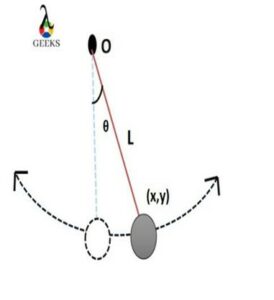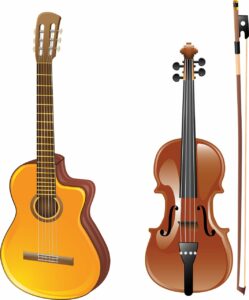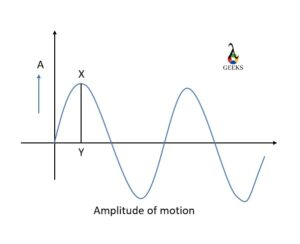The maximum displacement of the body from either side of the central point is the amplitude. Let’s see some amplitude of motion examples.
- Simple Pendulum
- Swing
- String Musical Instruments
- Spring
- Bungee Jumping
- Eardrums
- Cradle
- Torsion Pendulum
- Bouncing ball
Simple Pendulum
A simple pendulum is a particular form of the pendulum in which the length of the string is much larger compared to the mass of the suspended body. For the example of simple harmonic motion, we can take The motion of a simple pendulum. On striking the mass hanging from the string, it starts moving to and fro. In this condition, a restoring force arises to oppose the movement of the body.

In the figure above, we can see that the pendulum is moving from central point to either side and then passing through that it reaches the maximum point. The maximum distance between central point on both sides is its amplitude. This is an amplitude of motion example.
Swing
The swings in the children’s playground are another amplitude of motion example. When we apply force using the weight of our body, the swing starts moving forward and backward. Along with force generated by us, a restoring force also starts acting to restrict the motion of the swing. Now the maximum displacement that the swing makes in the forward or backward direction is inferred as its amplitude. Greater amplitude more will be the restoring force. The swing reaches higher when its amplitude is greater.
String Musical Instruments

Musical instruments like violin, guitar, and sitar are taken as examples of simple harmonic motion. When we strike the string, they start making vibrations. These vibrations start generating sound waves. When these waves enter our ears, we hear music.
The strings of these instruments are displaced to the maximum distance, which is known to be the amplitude of motion. If we beat the strings with great intensity, it would result in a larger amplitude. Since the restoring force varies directly with the amplitude, it would increase too. But the other factors of motion balance out the effect.
Spring
A bob dangling from an upright spring is also an example of simple harmonic motion. When we hang a body, the spring stretches to some extent and then comes into constant upwards and downwards motion. A force comes into action to restrict the motion.
In the diagram above, the initial position of the spring is. When we attach a mass, it stretches to the point and comes into motion. The displacement is the amplitude of the moving spring. Whether it is a vertical or horizontal arrangement, the amplitude is found in the same way.
Bungee Jumping

Bungee jumping is an adventurous activity in which a person tied to a string jumps off the cliff. Bungee jumping has two steps, one the free fall. And the other after free in which the strings extend till full length and pull the person up. And hence the string comes into simple harmonic motion.
The force acts on the string in an upward direction that opposes its motion in a downwards direction. The force here concerns Hooke’s law. The gravitational force acts in a downward direction. Hence the person oscillates up and down. Now the extent to which the person is pulled is the amplitude of the string or cord.
Eardrums
Without simple harmonic motion, hearing is not possible. A vibrating body produces sound waves. These waves reach the eardrum and start vibrating it. The motion of the eardrum is the simple harmonic motion.

It is also the amplitude of motion examples. The motion of the eardrum can be shown in the wave diagram. The peak distance is the amplitude of the motion. Louder sound leads to high amplitude, and softer or low sound leads to low amplitude.
Cradle
This is one of the basic examples, the physics behind it is very simple and easy to understand. A cradle is a baby’s bed, also known as a rocker, as it keeps rocking to make them fall asleep. To bring the cradle in motion, it has to be struck and start moving backward and forwards. Now the height till which the cradle rises is known as its amplitude.
Torsion Pendulum
The torsion pendulum is the one whose weight rotates in the opposite direction alternatively. Usually, it has a disc attached to the string, which twists, and the motion comes into action. It is an example of angular simple harmonic motion.
Since it is an angular simple harmonic motion, therefore, its amplitude is defined as the maximum angular displacement of the mass from the central position. For the motion to be angular simple harmonic, the amplitude should be kept small. If the circumstance reverses, then the motion would no more be simple harmonic.
Bouncing Ball
A bouncing ball is just a simple toy. When you strike it hard on the ground, it starts bouncing up and down. The amplitude of this ball is the maximum height it attains while in motion. Hence, it is also the amplitude of motion examples.
Frequently Asked Question (FAQs)
What are the types of motion?
In physics, there are different types of motion based on various factors.
The motions are categorized into six varied types. They are translation movement, rotational, oscillation, and uniform circular motion, and periodic motion. Further, we can also classify them into vibrational and simple harmonic motion.
Explain simple harmonic motion.
Simple harmonic motion is a particular type of periodic motion.
The simple harmonic motion is the one in which an object makes to and fro movement. During the motion, a force emerges that tries to oppose the movement. The movement of the pendulum and spring is an instance of simple harmonic motion.
What is the amplitude of a motion?
The amplitude is one of the defining terms of the motion.
Amplitude is the absolute measure of the displacement of the body or object from the mean position. It can be negative and only suggests that displacement is done in the opposite path. Amplitude is denoted by the symbol A, and its units are meters.
Explain the amplitude of motion examples.
The spring of strings of musical instruments and bungee jumping are all amplitude of motion examples.
When we hang a mass on the spring, it stretches to some extent and then comes into motion. The maximum displacement of the spring gives the value of its amplitude.
What is the amplitude of a pendulum?
A Pendulum is a simple instrument with a bob of the mass hanging from a string.
The pendulum moves to and fro, making oscillations. See the figure above, and you can see that the amplitude of the pendulum is the distance to which it extends to both sides.
Also Read:
- Periodic motion examples
- Curvilinear motion examples
- Passive range of motion examples
- Newtons laws of motion
- Vertical motion examples
- Two dimensional motion examples
- Multiple motion examples
- Simple harmonic motion examples
- Linear motion examples
- Periodic motion vs simple harmonic motion
Hi,
I am Rabiya Khalid, I have completed my masters in Mathematics. Article writing is my passion and I have been professionally writing for more than a year now. Being a science student, I have a knack for reading and writing about science and everything related to it.
In my free time, I let out my creative side on a canvas.